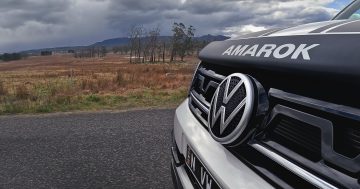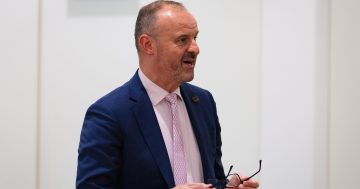
Urban kangaroos are a frequent sight in Canberra’s streets. Photo: Supplied.
Culling the ACT’s kangaroos has caused plenty of angst over the years. But should we eat the urban roos instead of dumping them? Professor George Wilson from the Fenner School of Environment and Society at the ANU says that an improved Australian kangaroo meat industry would have benefits for animal welfare and the environment both locally and around Australia.
Professor Wilson, who has extensive experience in wildlife management, rubbishes the widespread notion that Canberra’s booming kangaroo population are drought refugees. He points out that the lush greens of the ACT’s golf courses and a lack of top-order predators create comfortable living conditions.
“The idea that drought-affected wild kangaroos are coming in from the bush is nonsense”, he says. “These are local roos, born and bred here in Canberra. I see them every day like clockwork, coming down off Red Hill and onto the Federal golf course. The only danger most of them are in is being hit by a golf ball.”
Wilson’s difficulty is not with local measures to keep the kangaroo numbers down, but what happens after that. “ACT Parks and Conservation shoot these animals and then put them in a hole. I’d like to see the kangaroo meat industry much better organised, here and elsewhere, to make better use of the resource,” he says.
The ACT government has consistently said that kangaroo cull numbers wouldn’t support a commercial industry and that there is no commercial use for carcasses.
But Professor Wilson believes that attitudes to the kangaroo meat market are outdated. “These kangaroos are part of the pastoral system. If they were worth more money there would be greater interest from all landholders in managing their welfare.”
“My view is that the industry is about where beef was 40 years ago when nobody paid much attention to quality beyond the farm gate. Beef producers now manage product all the way down the value chain, so the quality of beef is now much better.”
Wilson says that wild kangaroo meat is worth about 60c a kilo, while goat meat sells at $7 a kilo because producers are now investing in managing the product. He’d like to see Meat and Livestock Australia apply their marketing, research and development services to managing the kangaroos on ratepayer properties, although he concedes there would probably be some resistance from vested interests.
“Currently we see kangaroo numbers crashing in droughts, I think the next round of aerial surveys will show a lot of starvation and death, and that is just not good enough. If we increase the value and boost the product demand that will work against the population boom and bust cycles.”
Wilson argues that there are also significant environmental benefits in a well-managed kangaroo meat market, pointing out that unlike ruminants, the marsupials don’t produce methane. He reckons that cattle methane alone is two thirds the volume of that produced by the transport industry in Australia.
“If a grazier has 500 kangaroos and 1000 cattle, they could be encouraged to reduce the number of cattle by 500. If they replace their volume of beef production by harvesting kangaroos instead, they’ve also generated a carbon offset that could be sold into the market.”
He’s frustrated by the Federal government’s focus on increasing beef production when, he says, managing kangaroo populations better would lessen our environmental footprint, benefit animal welfare and help graziers by diversifying their income stream.
“I’m on my way to Dubbo this afternoon to speak to the Western Division of the NSW Farmers Association. There are plenty of farmers and graziers that think this is an excellent idea. We just need more support and investment in the existing industry. We don’t need to reinvent the wheel.”
Do you eat kangaroo meat? Should the Territory government make better use of the kangaroo cull carcasses?
















